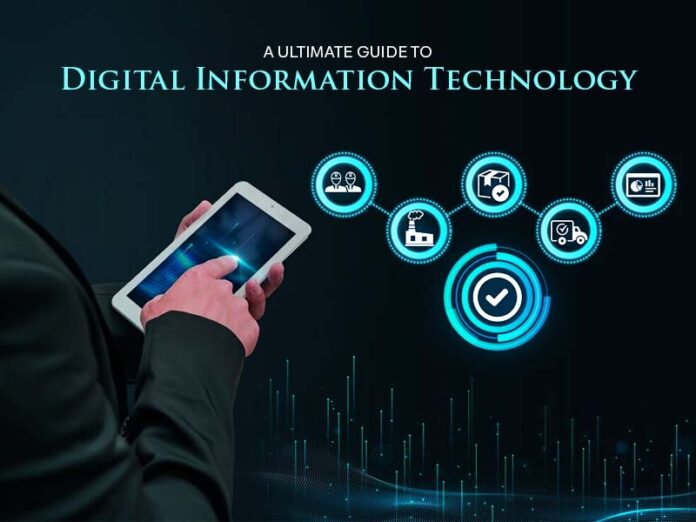Have you ever wondered what are the drivers behind this fast-paced transformation? In the rapidly evolving landscape of the 21st century, digital information technology (DIT) is not just an emerging trend but a fundamental driver of transformation across all sectors. The evolution of digital technologies has reshaped the way we interact, work, learn, and solve problems, paving the way for a future that is increasingly interconnected and intelligent.
This blog post explores how the evolution of digital information technology is empowering tomorrow’s world, discussing its impacts, challenges, and the potential pathways it opens for the future.
What is Digital Information Technology (DIT)?
DIT refers to the broad domain that focuses on the use and management of information through digital means. It uses a wide array of tools, systems, and methods employed for collecting, storing, processing, transmitting, and retrieving data and information electronically.
Now the main question is how it works. Don’t worry! I’m here to explain everything about the working principle of digital information technology.
This technology uses computer software and hardware to perform a variety of tasks ranging from basic data processing to complex problem-solving operations. This includes the development of databases, information management systems, networks, and cybersecurity measures. The technology operates on binary code – data represented in 0s and 1s – which enables vast amounts of information to be stored and processed efficiently.
The field is constantly evolving, driven by innovation and the continuous advancement of technology, leading to emerging areas such as artificial intelligence, big data analytics, and cloud computing. This continuous evolution shapes the way information is managed and utilized, highlighting the dynamic and influential nature of digital technology in the modern world.
What is the difference between IT and Digital Information Technology?
When it comes to technology, there is always confusion about the type and role it plays in societies. Information Technology (IT) and Digital Information Technology sound similar. Isn’t it? But there is a huge difference between these two paths. Let’s unfold all the mysteries about these two technologies.
Information technology (IT) offers a wide range of technologies involved in the creation, storage, exchange, and use of information in its various forms. This field includes hardware (computers, servers, networking devices), software (applications, operating systems), and the infrastructure and processes for managing these resources.
IT primarily focuses on the technology itself, including its development, implementation, and maintenance. It is instrumental in ensuring that technological resources are effectively employed to meet the information needs of individuals and organizations.
On the other hand, DIT is more specifically focused on the digital aspects of information handling. It involves the use of digital tools, technologies, and systems to process and manipulate information electronically. This field leans heavily on digital communication and the internet, emphasizing digital data management, transmission, and retrieval. They often incorporate elements of IT but are more concentrated on the transformation and utilization of information in digital formats.
It is broader and covers all types of information technologies, including those that do not necessarily involve digital data, such as older analog technologies. DIT, conversely, is a subset of IT that specifically targets digital data and the tools and processes for handling it.
In practical terms, IT professionals might deal with a range of technologies from server management to network infrastructure. In contrast, professionals in Digital Information Technology (DIT) would be more focused on aspects like digital data management, cybersecurity specific to digital data, and digital communications technologies.
As technology evolves, the distinction between these two fields is becoming more confusing. However, the fundamental difference remains in the general breadth of IT versus the specific focus on digital technologies.
Let’s End This…
In a nutshell, the evolution of Digital Information Technology stands as a cornerstone in shaping a progressive future. It not only enhances efficiency and connectivity but also fosters innovation across various sectors. The expansion of digital data management, cybersecurity, and digital communication is not just a technological advancement; it’s a paradigm shift that empowers individuals, businesses, and societies to achieve more. Incorporating this technology requires adaptability, continuous learning, and an inclusive approach, ensuring that the benefits of digital technology are accessible to all, paving the way for a more connected and efficient tomorrow.
FAQs About Digital Information Technology
Ques 1. How information technology will help us in the future?
Ans. Here are some ways information technology will help us in the future:
- Virtual Reality (VR)
- Personalised Interactions
- Providing Hassle-Free Customer Support
- Improved Connectivity
Ques 2. What do you mean by digital empowerment?
Ans. When someone is capable of using information technology to get better access to digital technologies such as electronic devices, tools, software, etc. Overall, you can say any technology that is used in daily life.
Ques 3. What are the advantages of digital technology?
Ans. Here are 5 basic advantages of digital technologies:
- Connect Anytime
- Improved Communication
- Data Processing & Storage
- Automation
- Great Learning Opportunity
Ques 4. How is digital information technology transforming business and economy?
Ans. With the help of DIT, companies can easily seamlessly connect with their customers. E-commerce, digital marketing, and remote working are just a few examples of how digital technology is reshaping the economic landscape.
We hope this article will be helpful to you. Stay tuned for upcoming articles.
READ MORE: Amazon GPT44X: Transforming AI Technology
If you like our article, please subscribe to BsyBeeDesign for the latest updates on design. If we forget anything, share your creative ideas in the comments section.
Follow us on Facebook, Linkedin, Instagram, Pinterest, and YouTube.


































